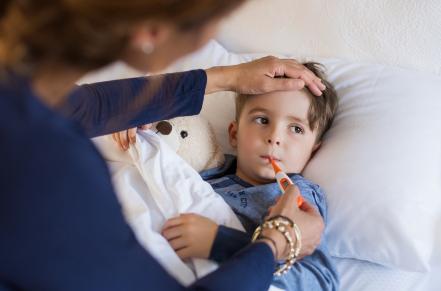What Is It?
Molluscum contagiosum is a common skin infection caused by a virus that is only found in the skin. The virus does not circulate in the body or cause a general illness, but the infected skin looks unusual and can last for months. It is especially common in children 2 to 5 because they have immature immune systems and frequent physical contact with each other.
What Are the Symptoms?
Molluscum appears as separate, round bumps, or lesions, that are pearly or skin-colored. They are smooth, firm, and dome-shaped with a dimple in the center. They range in size from a pinhead to 1/4 inch wide. Molluscum lesions are frequently seen on the face, neck, trunk, arms, and hands but may occur anywhere on the body except the palms and soles. They are sometimes itchy, but not painful. The infectious part of the lesion is in the cheesy substance that is found in the center dimple. The lesions may be in a group of 1 to 20 on one area of the body or they may also be all over the body.
Who Gets It and How?
Molluscum is spread by direct skin-to-skin contact or indirectly through touching surfaces or objects like towels, toys or clothing. It may also be spread in swimming pools. Children can spread the lesions from one part of their body to another. Children can get molluscum non-sexually in both genital and non-genital areas. The average incubation time is between 2 and 7 weeks but can be as long as 6 months. Molluscum eventually goes away, but can last for months. Molluscum often upsets parents because the rash often occurs in a very visible place on the body and may embarrass the child or parents. In children with poorly functioning immune systems, molluscum may be more extensive and last longer. It may also last longer in children with eczema. A person can get molluscum more than once.
How is it treated?
Molluscum lesions will eventually go away without treatment. But, there are treatments for molluscum that can help the lesions go away more quickly than they would without treatment. The treatments can be painful and/or may cause scarring. Treatments may need to be repeated.
Molluscum should be diagnosed and treated by a health care provider, especially if the lesions are spreading rapidly. Home treatments are not known to be effective.
How can I limit the spread?
Lesions are mildly contagious and most often spread to other areas of the affected child’s body rather than to other children. If children scratch or pick at the lesions, a secondary bacterial infection may occur. Covering the lesions is usually not necessary unless a child is picking or scratching them. Applying ice packs to itchy areas can help reduce the urge to scratch. Affected children should have their own ice packs to avoid spreading the infection to other children. Chewing or sucking a molluscum lesion can spread the bumps to the lips or face. Children with molluscum should not share clothing or towels with others. Good handwashing and routine cleaning and sanitizing are also important ways to prevent the spread.
When Should People with this Illness Be Excluded from ECE Settings?
Children with this rash should not be excluded from ECE settings. Molluscum is a nuisance, not a serious health problem
Where Should I Report It?
Molluscum contagiosum is not a reportable disease.







